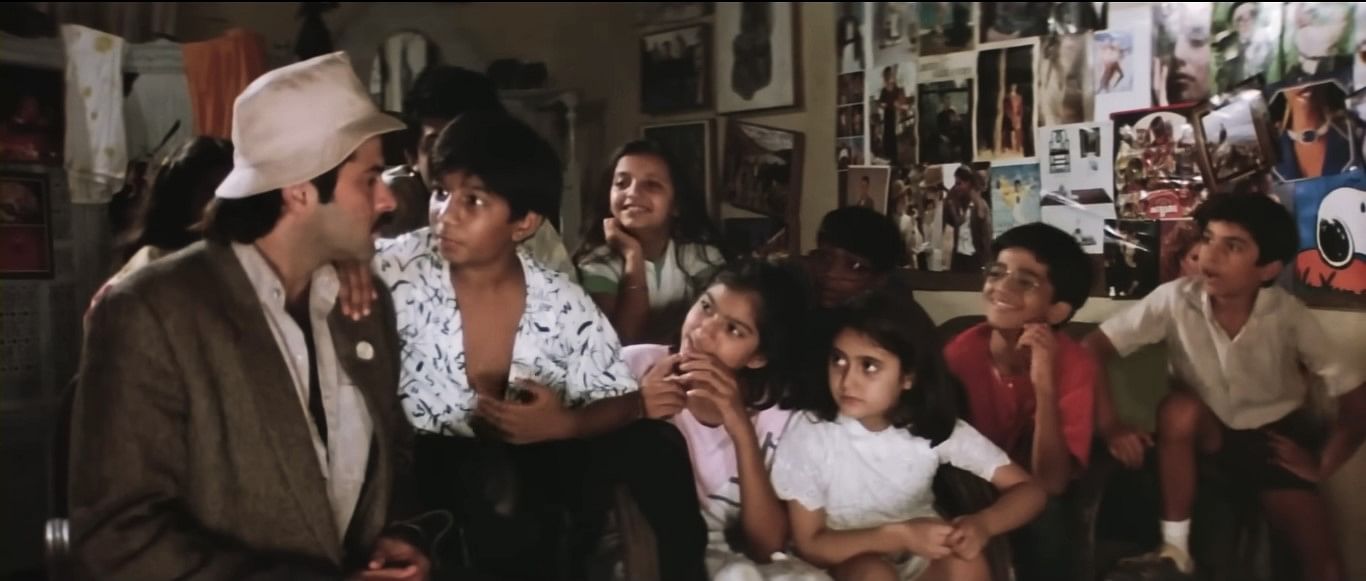
Mr India: Anil Kapoor in 'Mr India' (1987) with a mischievous gang.
Credit: iMDb
One of few accessible Indian films of the silent era, Dadasaheb Phalke’s ‘Kaliya Mardan’ (1919) is renowned for attempting early special effects. The film’s other highlight: its child star, Mandakini — Phalke’s seven-year-old daughter and one of the first child artistes of Indian cinema. Phalke presents her on screen with great adulation and flourish. A shot of Mandakini’s smiling face dissolves to her turning into Krishna. She conveys a variety of expressions. An intertitle invites viewers to study the young performer’s range. In the promotional material of Kaliya Mardan and Phalke’s other mythological films she starred in, little Mandakini is hailed as a wonder child epitomising the flute-playing god.
From the cherubs in the early mythological fares to the eagerly virtuous children of the ‘50s to the angry, avenging lot of the ‘70s-‘80s masala-actioners, the image of child artistes in Hindi cinema keeps evolving. Their characters, actions and motivations reflected the mood of the time and their milieu. The insufferably sanctimonious minors in the sappy family dramas, the misfortune-prone ‘bechaare bachche’ in Manmohan Desai movies, wayward brats who’d grow up to be the baddies, awfully infantilised children of yore, and the wily, precocious kids of contemporary cinema — Bollywood has spoken about the innocence of childhood and its loss, the real and the ridiculous, and more.
Child artistes like Daisy Irani, Master Raju, and Mehmood Junior attained phenomenal success in their careers and were considered major movie attractions. Baby Farida in 1960s, Master Bittoo in the ‘70s and Kunal Khemu in the ‘90s — with their constant and familiar presence on the celluloid became the definitive child stars of their era. A few like Neetu Singh, Sarika, Sachin, and Urmila Matondkar transitioned into successful stars as adults. But the majority of Bollywood child artistes have faded away. Little information on them is available in the public domain. Most child artistes routinely played both boy and girl roles. Many were known to have both male and female screen names. For instance, Daisy and Sarika were credited as Moppet Roop Kumar and Moppet Suraj respectively as they were often cast as young boys.
Amar Akbar Anthony: The brothers in 'Amar Akbar Anthony' (1977) before their separation.
Kaliya Mardan: Mandakini Phalke in 'Kaliya Mardan' (1919).
Boot Polish: Baby Naaz, Rattan Kumar and David in 'Boot Polish' (1954).
Masoom: Jugal Hansraj, Urmila Matondkar and Aradhana Srivastav in 'Masoon' (1983).
Bombay cinema of the ‘50s made significant strides for child artistes. The decade produced several mainstream children-centric films: ‘Jagriti’ (1954), ‘Boot Polish’ (1954), ‘Toofan Aur Deeya’ (1956), and ‘Ab Dilli Dur Nahin’ (1957) featuring the era’s notable young performers — Rattan Kumar, Baby Naaz, Master Romi among others. The post-independence idealism shaped the image of onscreen children. They spoke of honesty, unity, perseverance, and nation building. Concurrently, the harsh realities of marginalised minors, too, evoked strong social commentary. ‘Boot Polish’ highlighted the crushing struggles of destitute children through the story of two orphan siblings. Many works of neorealist filmmakers K A Abbas (Munna, 1954) and Bimal Roy (Do Bigha Zamin, 1953) captured the social apathy towards street children. This growing disillusionment and struggle against an unfair society was reflected in the later portrayal of children. Writer duo Salim-Javed, instrumental to this shift, also explored how the trauma of injustices impacted these young characters.
Also consider these tropes involving child actors. Master Alankar’s wronged young Vijay in ‘Deewaar’ (1975) became the prototype for a slew of wounded, retribution-seeking filmi kids. In many films, child actors are conduits for the protagonist’s origin story and character development. A shot of a (running) child’s legs turning into an adult’s was a Bollywood staple. Sometimes they provided comic relief; at other times, they just needed to complete the family portrait. They sang lovely ditties too. Think the glorious parody song from ‘Mr India’ (1987), an adorable Honey Irani in ‘Nani teri morni’ from ‘Masoom’ (1960), or the quirky charm of the other ‘Masoom’’s (1983) evergreen classic ‘Lakdi ki kaathi’. There’s also the exploration of compassion and friendship through their bond with animals. Be it fantasy (Rani Aur Lalpari, 1975), adventure (Balak Aur Janwar, 1975; Do Bachche Dus Haath, 1972), or family drama (Minoo, 1977; Anokha Bandhan, 1982) — kids with a loving pet or trusted animal companion was a recurring trope across genres.
Films centred on kids have resulted in some of the most nuanced takes on childhood and the whims and curiosities of the young minds. In ‘Kitaab’ (1977), ‘Masoom’ (1983), and ‘Zakhm’ (1998), the complex world of grownups is examined through a child’s perspective. ‘Makdee’ (2002) is a fantastic horror comedy that debunks superstitions. The delightfully chaotic kids of ‘Mr India’, the mutinous cuties of ‘Parichay’ (1972), and ‘Brahmachari’’s (1968) goofy gang remain Bollywood’s most beloved child star casts.
The most significant work in children’s films has happened outside of Bollywood. Independent filmmakers and the Children’s Film Society of India — the film body focussed on children as its audience – have been producing insightful, engaging, and socially-relevant cinema in major languages. Classics like ‘Charandas Chor’ (1975), ‘Halo’ (1996), ‘Malli’ (1998) to festival-feted, contemporary titles like ‘Gattu’ (2011), ‘Village Rockstars’ (2017), ‘Dostojee’ (2021) to name a few. However, current Hindi cinema is happy to experiment. The success of ‘Taare Zameen Par’ (2007), ‘Stanley Ka Dabba’ and ‘Chillar Party’ (2011) and high praise for recent films like ‘Toolsidas Junior’ (2022) demonstrate that the void of meaningful mainstream children’s cinema can be filled.